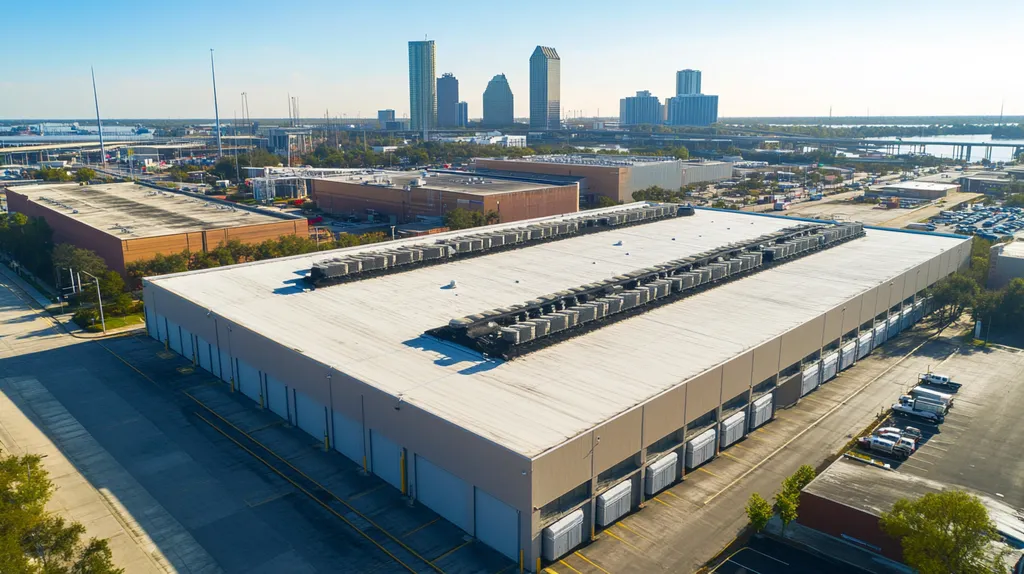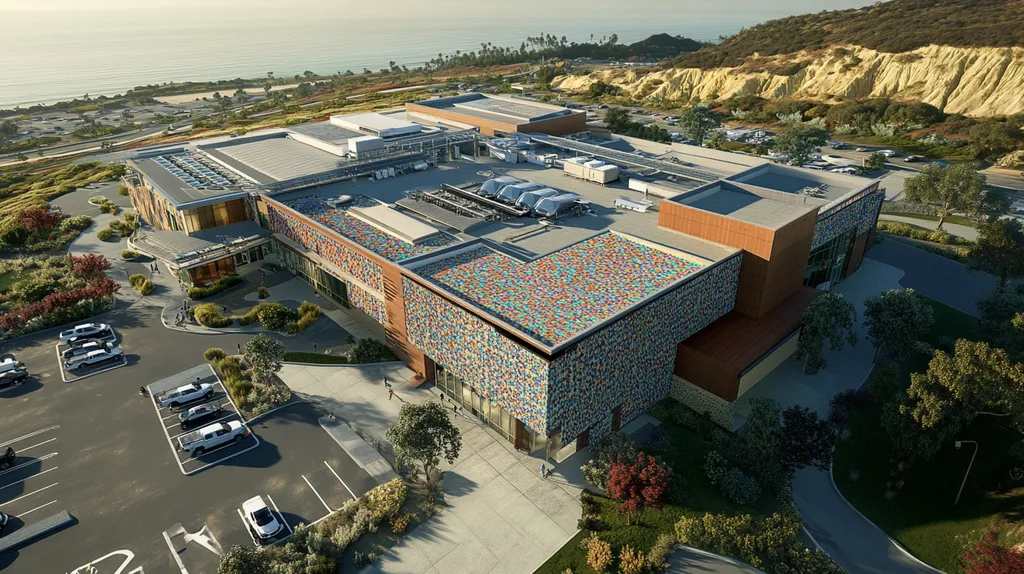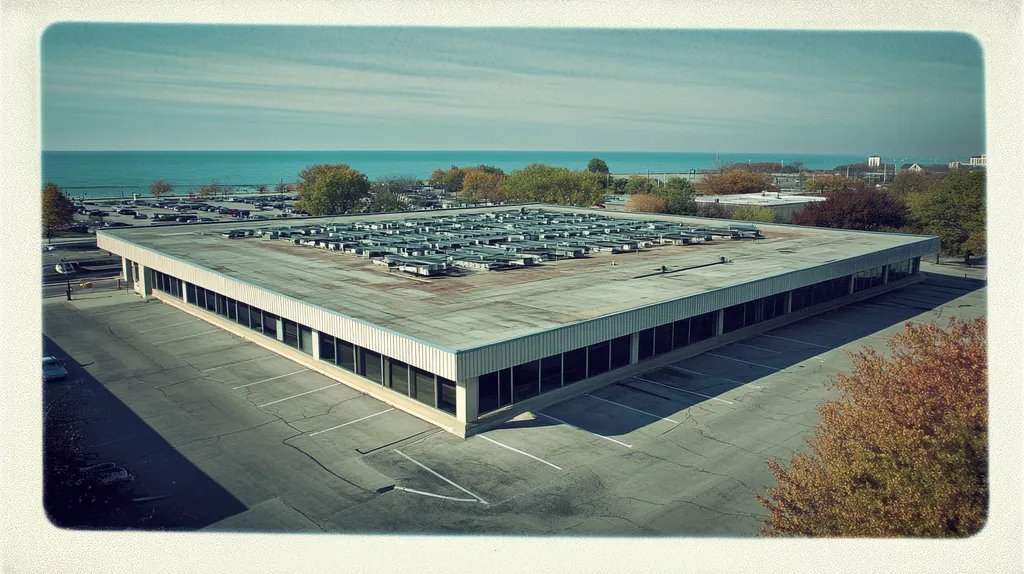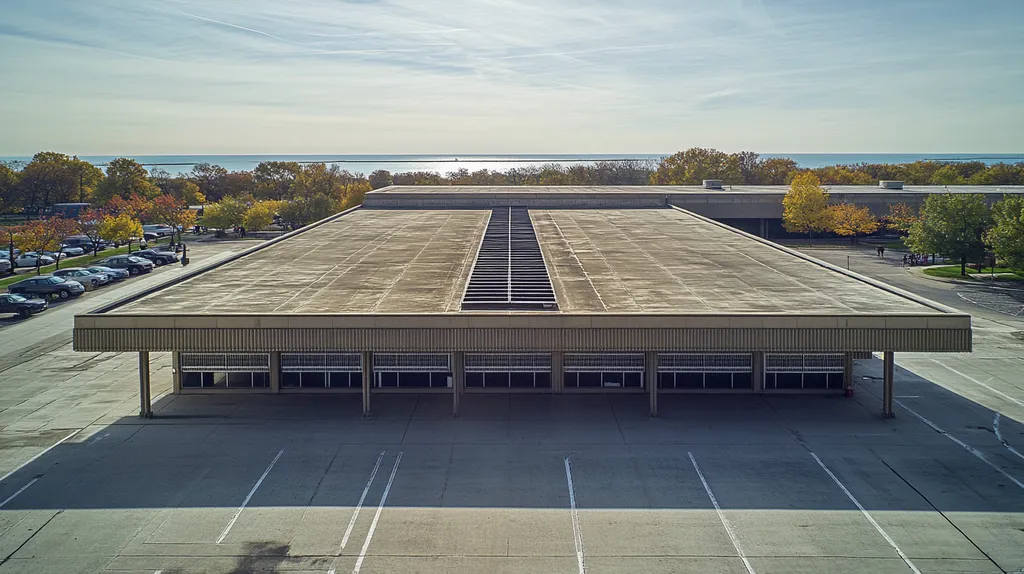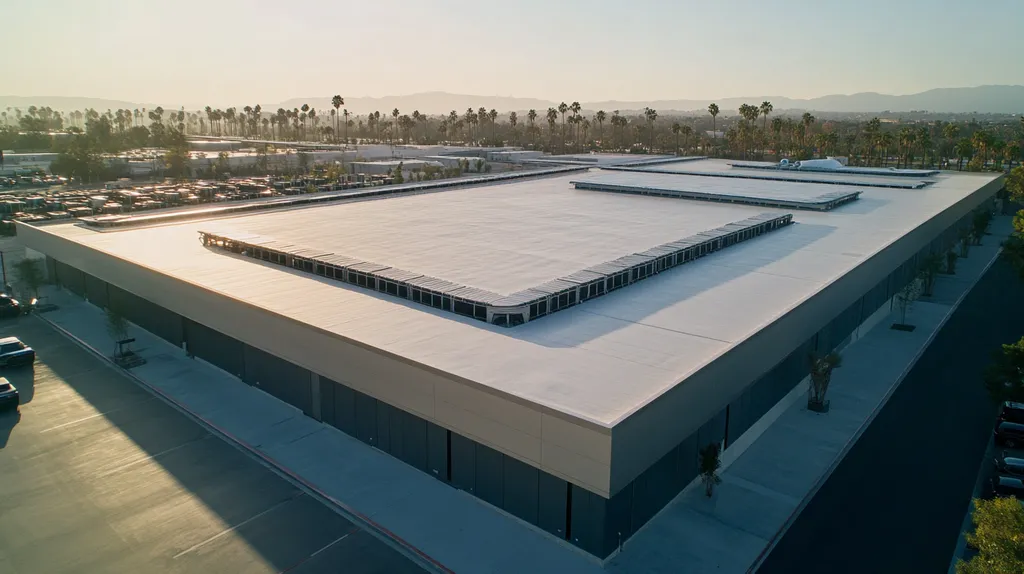Every year, commercial buildings suffer over $3.7 billion in damage from inadequate roof drainage, yet traditional training approaches continue to fall short in preventing these losses.
Despite mounting evidence that proper drainage education could prevent up to 70% of roof failures, many facility managers still rely on outdated, ineffective training methods that leave staff ill-equipped to handle critical maintenance tasks.
This analysis examines why conventional drainage education fails, explores the systemic issues perpetuating these problems, and presents data-driven solutions for protecting commercial roofing investments through enhanced staff training.
SECTION 1: CURRENT PRACTICES
Effective roof drainage is not just a recommendation; it’s a necessity for the longevity and safety of commercial buildings. When drainage systems fail, the consequences can be severe, including structural damage, mold growth, and significant repair costs. Alarmingly, a staggering 40% of commercial roofing failures stem from poor drainage management. Property owners and facility managers must grasp the intricacies of drainage systems to safeguard their investments and maintain the integrity of their roofs.
Gutter Systems in Commercial Roofs
Gutter systems have long been a staple in commercial roof drainage. Their primary role is to collect rainwater and channel it away from the roof and the building’s foundation. However, relying solely on gutters can be risky, especially during heavy rainfall.
When gutters become clogged, they can overflow, causing water to pool on the roof’s surface. This standing water not only adds excess weight to the structure but also accelerates the deterioration of roofing materials. Left unchecked, the situation can escalate into leaks and significant water damage.
Moreover, gutter maintenance often falls to the wayside within property management teams. Without regular inspections and cleanings, the buildup of debris can severely hinder drainage efforts.
Therefore, while gutters are an important component of a roof drainage strategy, they shouldn’t be the only measure in place. An integrated approach that incorporates multiple drainage methods is essential to effectively manage roof runoff.
Inner Roof Drains and Their Implementation
Inner roof drains are vital for managing water on flat roofs effectively. Positioned at the low points of the roof, these drains funnel water directly into the building’s drainage system. However, their effectiveness hinges on proper installation and placement.
Unfortunately, many facility managers underestimate the importance of drain positioning. If inner drains are incorrectly located, they may fail to handle expected water volumes, leading to localized flooding. Regular inspections and maintenance are crucial to ensuring these drains operate as intended.
Training staff about the maintenance of inner drains is frequently neglected. Many managers may not recognize the critical need to keep these drains free of debris and how to perform inspections effectively. Raising awareness in this area can substantially mitigate the risk of costly water damage.
In conclusion, while inner roof drains are essential to drainage systems, their strategic placement and ongoing maintenance education are crucial for optimal performance.
Scupper Drains and Their Limitations
Scupper drains are a typical feature in many commercial roofing systems, especially in sloped-roof designs. Their purpose is to allow water to exit the roof directly over the edge, helping to facilitate drainage. However, scuppers have notable limitations that need attention.
The main drawback is their susceptibility to blockage from ice, debris, or snow. Such obstructions can hinder water from escaping, leading to possible flooding or damage to the roof. Thus, diligent monitoring and maintenance are necessary to keep scuppers clear and functional.
Additionally, scuppers are designed with specific water flow rates in mind. During intense rainfall, if the volume exceeds these rates, water can overflow the edges, undermining the benefits of having scuppers installed. Relying solely on scupper drains can expose buildings to the risk of damage during severe storms.
In summary, while scupper drains contribute to the overall management of roof drainage, their limitations highlight the need for a multi-faceted approach in drainage strategies to ensure effective water runoff control on commercial roofs.
SECTION 2: SYSTEMIC ISSUES
Proper roof drainage is not just a trivial concern; it is a vital element that protects the very framework of commercial buildings. Neglecting drainage maintenance can lead to dangerous water accumulation, resulting in leaks and costly structural damage. Alarmingly, the National Roofing Contractors Association reports that nearly 60% of all roofing failures are tied to inadequate drainage. This section will delve into the maintenance hurdles that exacerbate these problems, the common issue of blockages in drainage systems, and the expensive repairs that can arise from such neglect.
Maintenance Challenges in Drainage Systems
Maintaining efficient drainage systems is a daunting task for many property management teams. The necessity of regular inspections often gets sidelined due to conflicting schedules and tight budgets. This oversight can go unnoticed until significant water issues arise, leading to expensive repairs.
Staff members may lack an understanding of the critical nature of routine maintenance. Without adequate training, they may miss crucial indicators, such as standing water or accumulated debris, which can worsen drainage problems if left unaddressed.
Furthermore, each roofing system has unique maintenance needs, complicating the training process. A one-size-fits-all approach can lead to neglecting specific materials or designs, permitting issues to fester.
The end result is a cycle of reactive management where problems are only addressed after they escalate, increasing the financial burden on property owners.
Clogging and Blockage in Drainage Pipes
Clogs in drainage systems pose a direct threat to the safety and integrity of any commercial roof. Leaves, debris, and even organic growth can accumulate, resulting in hazardous blockages. When these drains fail, water begins to back up, creating pools that add weight, stress, and potential leaks to the roof structure.
The danger of blocked drains is not just immediate; they can lead to severe long-term damage. Water infiltrating seams and joints can rot underlying materials, ultimately compromising the roof’s structural integrity. This underscores the importance of regular cleaning and timely inspections to catch issues before escalation.
Relying on the assumption that drains will function without intervention can be misleading. Many property managers neglect this aspect of maintenance, leading to unanticipated service interruptions and costly repairs when drainage fails.
Implementing effective training strategies can empower staff to identify signs of potential clogging early—allowing timely actions to prevent financial strain down the line.
Costly Repairs and Hidden Dangers
The failure to maintain proper drainage can lead to significant financial strain. The costs associated with repairing water-related damage can be astronomical, often leading to urgent, expensive solutions or even complete roof replacements.
Moreover, the dangers posed by undetected moisture can linger long after the initial issue, giving rise to toxic mold growth and jeopardizing the structural stability of the building. These risks can often go unnoticed until they escalate, exposing property owners to potential liability and legal challenges.
By investing in proactive drainage maintenance, property owners can mitigate these severe risks and prolong their roofing system’s lifespan. Creating a culture of vigilance around drainage maintenance ensures that no issue slips through the cracks.
In conclusion, prioritizing education about early detection and regular monitoring of drainage systems is essential. By addressing these systemic challenges, property owners can protect their investments from unforeseen costs and dangerous situations.
SECTION 3: MISSED OPPORTUNITIES
Failure to prioritize education on proper drainage can have dire consequences for the longevity and effectiveness of commercial roofs. Alarmingly, research indicates that a staggering 70% of roof failures can be attributed to poor drainage practices and inadequate maintenance. Ignoring vital aspects such as gravity-driven drainage, overlooking regular maintenance schedules, and failing to integrate functional design can create costly repairs and structural setbacks. Each of these areas represents a missed opportunity for education that could lead to more efficient water management and extend the lifespan of roofing systems.
Overlooking Gravity-Induced Drainage
Understanding the principle of gravity in drainage is fundamental yet often neglected by facility managers. A well-designed roof should facilitate water flow toward drainage points, preventing stagnant water from accumulating. When this principle is overlooked, the consequences can be severe—stagnant water can lead to leaks, structural deformation, and even total roof failure.
For instance, flat roofs lacking sufficient slope can trap water, creating undue stress on roofing materials. Educating staff on effective gravity-driven drainage can help eliminate these design flaws, fostering better practices that protect the roof’s integrity. Incorporating proper drainage design from the initial stages is essential for minimizing long-term repair costs.
Regular training on recognizing and resolving drainage issues allows quick action against water accumulation. Without a focus on drainage education, property owners expose themselves to severe financial impacts caused by preventable oversights.
Neglecting Regular Maintenance Schedules
A structured maintenance schedule is indispensable for ensuring the functionality of commercial roofs. Unfortunately, many facility managers overlook this proactive approach, paving the way for avoidable drainage complications. Periodic inspections can catch clogs, debris buildup, and other issues that severely hinder drainage efficiency.
Research shows that roofs adhering to regular maintenance schedules experience half the number of leaks compared to those that don’t. Without a solid regular maintenance plan in place, the risk of catastrophic failures skyrockets, resulting in ever-growing repair costs.
Training facility staff to identify warning signs during inspections cultivates a proactive maintenance culture. This approach significantly reduces potential damage from neglected maintenance needs—ultimately strengthening the relationship between property managers and contractors.
Ignoring Aesthetic and Functional Integration
Failing to integrate aesthetic and functional elements in drainage design is a common oversight in staff training. Many facility managers prioritize performance but overlook how drainage systems can blend seamlessly with the roof’s overall design. This lack of consideration can lead to visual distractions or functional problems down the line.
Improperly positioned drainage systems may block walkways or interfere with HVAC installations—issues that can complicate operations. A well-crafted drainage strategy should not only ensure optimal functionality but also enhance roof usability.
Moreover, aesthetically appealing drainage solutions can boost a building’s overall value. When these systems improve visual appeal, they contribute positively to tenant satisfaction and retention. Focusing on both functionality and aesthetics in training promotes the importance of thoughtful design, ensuring that drainage systems serve both practical and visual purposes.
SECTION 4: ROOT CAUSES
Identifying the root causes of poor roof drainage is crucial for preventing expensive repairs and ensuring the long-term integrity of commercial buildings. Design flaws, insufficient slope, and a lack of customized drainage solutions are significant contributors to these issues. Alarmingly, approximately 60% of flat roofs experience water pooling, leading to structural damage and soaring maintenance costs. For property owners, addressing these underlying problems is essential to safeguarding their investments.
Design Flaws in Commercial Roofing
Many commercial roofs are constructed with limited consideration for essential drainage needs. Common design flaws include improperly sized drainage openings and poorly situated downspouts. These miscalculations can result in water accumulation, increasing the risk of leaks and severe issues.
For instance, defects in roof design can lead to water stagnation, significantly reducing the roof’s lifespan. The repercussions extend beyond the roof itself, potentially causing damage within the building. Addressing these design issues as early as possible can save property owners from incurring costly remediation later on.
It is vital for architects and building professionals to prioritize proper drainage in their designs. Enhanced collaboration between roofing contractors and design teams can lead to better outcomes, effectively mitigating challenges associated with water buildup.
Adopting updated design standards focused on drainage efficiency is key. By investing in high-quality design, property owners can prevent long-term issues stemming from common oversights.
Inadequate Slope and Pitch Considerations
The slope of a roof is a critical factor necessary for effective water drainage. Many commercial roofs are constructed with minimal slope, leaving them vulnerable to pooling. If water isn’t adequately directed toward drains, it increases the risk of leaks and rot.
While building codes typically outline minimum slope requirements, these guidelines may fall short in addressing the realities of local weather conditions. For instance, accumulating debris can exacerbate drainage inefficiencies. Facility managers must regularly assess whether their roofs possess adequate pitch to handle their specific climate.
Educating staff about the importance of maintaining proper slope can lead to notable improvements in drainage outcomes. Regular inspections are essential to identify areas where slope performance may be lacking. Ongoing assessment and adjustments can dramatically enhance water management.
Utilizing recommended slope guidelines tailored to climate conditions improves overall roof performance. Ensuring proper slope and pitch should be a primary focus for property owners and managers alike.
Lack of Customized Drainage Solutions
Every roofing system has unique drainage requirements that necessitate customized solutions. Unfortunately, a one-size-fits-all approach is still prevalent in the industry, often resulting in subpar drainage performance. Customized solutions should take into account factors such as roof size, design, and environmental conditions.
For example, a large commercial facility in a region known for heavy rainfall may need a vastly different drainage strategy than a smaller roof situated in a drier area. Tailoring drainage solutions to address specific environmental challenges can greatly enhance effectiveness.
Investing in bespoke drainage systems can significantly reduce maintenance costs and prolong the lifespan of roofing materials. Property owners should engage with experts to develop strategies that align with their buildings’ distinct needs.
Planning for drainage systems over the long term allows staff to implement effective management practices. This foresight is crucial for maintaining roof health and protecting the overall investment in the building.
DATA DRIVEN EVIDENCE
Poor roof drainage poses a severe threat to the structural integrity of commercial buildings, often going unnoticed until major damage occurs. Alarming statistics reveal that around 40% of commercial roofs encounter drainage-related issues, leading to costly repairs, operational disruptions, and lost revenue. By prioritizing education on proper drainage maintenance, property owners can mitigate these risks and protect their significant investments. This section will explore the data-driven evidence of inadequate drainage impacts, highlight critical case studies of system failures, and outline the economic repercussions that follow.
Statistical Impact of Poor Drainage on Buildings
The statistics surrounding roof drainage failures are nothing short of alarming. Research indicates that nearly 75% of flat roofs suffer from water pooling because of inefficient drainage systems. This accumulation of water can instigate leaks, contribute to structural degradation, and shorten the lifespan of roofing materials.
Furthermore, a study reveals that properties with inadequate drainage are 2.5 times more likely to face leak-related damage. These figures underscore the urgent need for thorough maintenance practices that ensure effective drainage and protect the integrity of commercial roofs.
The costs involved in resolving drainage-related issues can spiral out of control. Facility managers frequently report averaging $30,000 annually spent on roof repairs due to poor drainage conditions, illustrating the need for proactive education and regular maintenance to prevent daunting expenses.
Understanding these statistics is critical for property owners as it highlights the urgent need to prioritize proper drainage systems. Neglecting maintenance can lead to catastrophic consequences, compounding repair costs and jeopardizing investments.
Case Studies of Drainage System Failures
Real-world case studies showcase the dire outcomes of overlooked drainage systems. One notable incident took place at a large retail facility where improper drainage management led to extensive water pooling, culminating in over $100,000 in repair costs within just a few months.
In another instance, a manufacturing plant faced continuous leaks stemming from a poorly designed drainage system. The relentless issues not only caused material losses but also triggered unplanned shutdowns, negatively affecting production schedules and revenue streams.
These cases underscore a broader trend across various industries, where ineffective drainage not only heightens maintenance costs but also results in serious operational disruptions. The lessons learned from these failures reinforce the necessity for comprehensive education on drainage system upkeep.
Such examples remind business owners of the profound impact that negligence in drainage maintenance can have on both physical assets and the bottom line, making the case for better training and vigilance in this area.
Economic Consequences of Inefficient Drainage
The economic fallout from failing to address drainage issues can be overwhelming. Property owners frequently bear escalating maintenance costs due to prolonged water damage, resulting in accelerated wear and tear on roofing materials.
In a national survey, businesses noted a staggering 15% increase in insurance premiums linked to recurring drainage-related claims. This financial burden affects property owners directly and filters down to tenants, inflating overall operational costs.
Additionally, any productivity loss stemming from operational disruptions due to drainage failures further erodes profits. Damage to equipment or inventory can lead to decreased worker efficiency, compounding the negative effects on business performance.
These economic ramifications highlight the critical need for enhanced education and proactive strategies regarding roof drainage management. By investing in proper maintenance practices, property owners can safeguard their investments and maintain stable financial health.
SECTION 6: ALTERNATIVE SOLUTIONS
With climate change reshaping weather patterns and intensifying storms, effective roof drainage has never been more critical. Ignoring advanced drainage solutions can lead to catastrophic consequences, such as structural damage and skyrocketing repair costs. Fortunately, innovative technologies and materials are emerging to dramatically enhance drainage performance. This section explores advanced siphonic systems, hybrid drainage approaches, and cutting-edge materials that promise optimal efficiency and safety for commercial properties.
Advanced Siphonic Drainage Systems
Traditional gravity drainage systems often falter during heavy rains, letting water pool on roofs. In contrast, siphonic drainage systems utilize suction principles to expel water quickly. This innovative approach reduces the number of drains required, lessening the risk of blockages and significantly boosting performance.
For example, a prominent commercial facility located in a flood-prone area switched to a siphonic system, reporting a remarkable reduction in water-related incidents. This fast water removal not only extends the roof’s lifespan but also preserves its structural integrity.
Implementing siphonic systems involves careful planning, including accurate load calculations and precise pipe sizing. However, the long-term benefits—minimizing repair costs and addressing drainage issues proactively—far outweigh the initial investment. Properties embracing these advanced systems are better positioned to protect their assets.
Moreover, by integrating advanced siphonic drainage, facilities not only enhance risk management but also contribute to sustainable building practices. As awareness grows, these systems could set new benchmarks within the industry for effective drainage solutions.
Hybrid Drainage Approaches for Optimal Efficiency
Hybrid drainage systems blend traditional and innovative methods for exceptional performance. By fusing gravity and siphonic systems, these approaches optimize efficiency and functionality, adapting seamlessly to various architectural designs and environmental conditions.
An effective hybrid system may employ gravity drains alongside siphonic technology, ensuring roofs are equipped to handle both everyday rainfall and extreme weather events. This versatility allows property managers the flexibility to create tailored solutions rather than relying on a one-size-fits-all model.
For instance, a commercial complex facing seasonal storms and heavy snowfall successfully implemented a hybrid drainage system, which greatly improved performance during adverse conditions. This adaptability not only lessens maintenance demands but also reduces operational costs over time.
Additionally, hybrid systems can be fitted with sensors that monitor water levels and identify potential blockages. This data-driven approach enhances proactive management, ensuring properties are safeguarded throughout the year.
Innovative Materials for Enhanced Drainage Performance
The introduction of modern materials is transforming roof drainage solutions. Advanced lightweight composites and membranes significantly boost drainage efficiency and longevity. These materials are designed to resist debris accumulation, allowing for improved water flow and reduced clogging risks.
Notably, surfaces that utilize self-cleaning technology can help maintain optimal drainage by naturally shedding contaminants. A commercial building employing such materials noted marked improvements in drainage efficiency during rainstorms, illustrating the benefits of innovation in enhancing roof durability.
Beyond performance enhancements, these new materials often align with sustainability goals, leading to increased energy efficiency and reduced environmental impact. Property owners investing in these cutting-edge solutions can expect not just better drainage but also lower long-term energy expenses.
As the commercial roofing industry continues to evolve, embracing innovative materials becomes crucial. Property owners who stay ahead in material technology will significantly mitigate risks tied to outdated roofing strategies.
Moving Forward
The $3.7 billion in annual commercial roof damage from poor drainage represents an urgent call for revolutionizing staff education approaches.
Traditional training methods continue failing to prevent up to 70% of preventable drainage failures, putting billions in property assets at risk.
The evidence clearly shows that implementing comprehensive drainage education programs, leveraging advanced siphonic systems, and adopting innovative materials can dramatically reduce these losses while extending roof lifespans.
For commercial property owners and facility managers, the choice is clear: invest in modern drainage education now or face exponentially higher costs from preventable failures later.
By embracing data-driven training approaches and emerging drainage technologies, the industry can finally address this persistent threat to building integrity and operational continuity.
FREQUENTLY ASKED QUESTIONS
Q. What are the common practices in commercial roof drainage?
A. Effective roof drainage is crucial for the longevity of commercial buildings. Common practices include using gutters, inner roof drains, and scupper drains. Regular maintenance and inspections are necessary to prevent clogs and ensure optimal water flow on roofs.
Q. How do systemic issues affect commercial roof drainage?
A. Systemic issues like inadequate staff training and neglected inspections lead to ineffective drainage. This oversight can result in dangerous water accumulation, costly structural damage, and increased maintenance expenses that property managers must address proactively.
Q. What are the missed opportunities in roof drainage education?
A. Ignoring drainage education leads to costly repairs and roof failures. Common oversights include neglecting gravity-driven drainage and failing to maintain regular inspection schedules. Education can empower staff to manage and prevent potential drainage complications effectively.
Q. What are the root causes of poor drainage in commercial roofs?
A. Major root causes include design flaws, inadequate slope, and a lack of customized solutions. These factors can lead to water pooling and increased risks of structural damage. Proper attention to these issues is essential for maintaining roof integrity.
Q. What does data-driven evidence say about roof drainage issues?
A. Data shows that around 40% of commercial roofs face drainage-related issues. Neglecting maintenance can lead to costly repairs and operational disruptions, highlighting the urgent need for proactive educational measures for facility managers and owners.
Q. What alternative solutions can improve drainage performance?
A. Advanced siphonic systems, hybrid drainage approaches, and innovative materials enhance performance. These solutions address climate challenges and reduce maintenance needs, making them essential for modern commercial roofing and effectively managing water runoff.
Q. How important is staff training in roof drainage management?
A. Staff training is crucial for effective roof drainage management. Well-trained staff can recognize potential issues, conduct timely inspections, and maintain drainage systems, significantly reducing the risk of costly repairs or structural failures.

